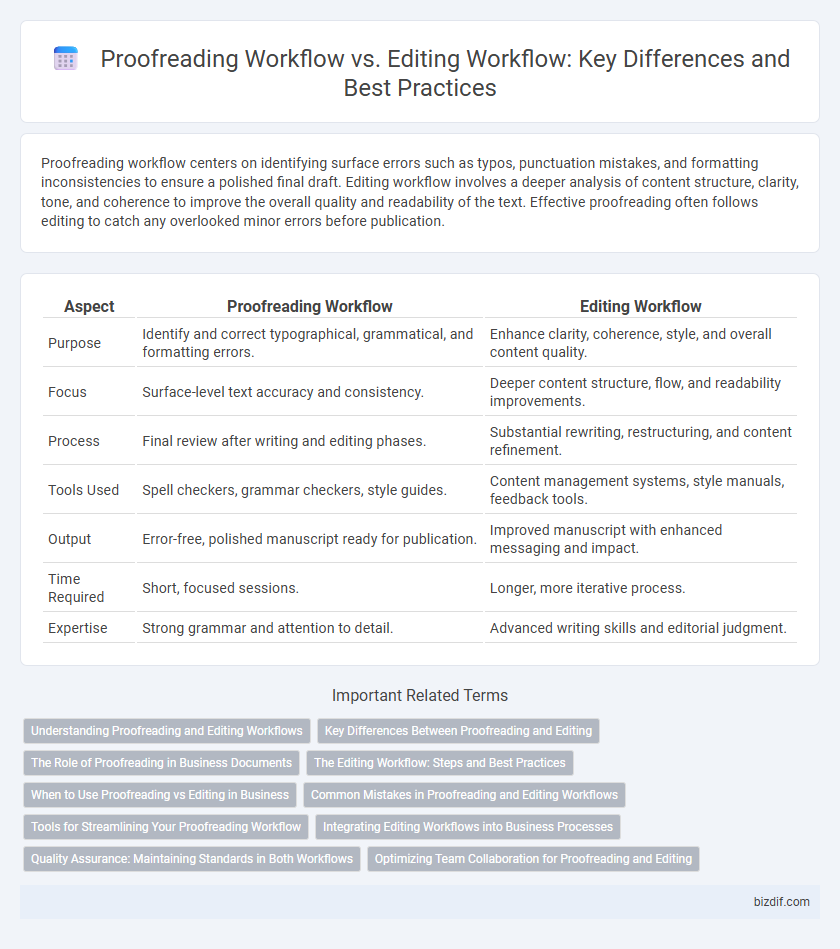Proofreading workflow centers on identifying surface errors such as typos, punctuation mistakes, and formatting inconsistencies to ensure a polished final draft. Editing workflow involves a deeper analysis of content structure, clarity, tone, and coherence to improve the overall quality and readability of the text. Effective proofreading often follows editing to catch any overlooked minor errors before publication.
Table of Comparison
| Aspect | Proofreading Workflow | Editing Workflow |
|---|---|---|
| Purpose | Identify and correct typographical, grammatical, and formatting errors. | Enhance clarity, coherence, style, and overall content quality. |
| Focus | Surface-level text accuracy and consistency. | Deeper content structure, flow, and readability improvements. |
| Process | Final review after writing and editing phases. | Substantial rewriting, restructuring, and content refinement. |
| Tools Used | Spell checkers, grammar checkers, style guides. | Content management systems, style manuals, feedback tools. |
| Output | Error-free, polished manuscript ready for publication. | Improved manuscript with enhanced messaging and impact. |
| Time Required | Short, focused sessions. | Longer, more iterative process. |
| Expertise | Strong grammar and attention to detail. | Advanced writing skills and editorial judgment. |
Understanding Proofreading and Editing Workflows
Proofreading workflows focus on identifying surface-level errors such as typos, punctuation mistakes, and formatting inconsistencies to ensure text accuracy and clarity. Editing workflows involve a deeper review process targeting content structure, sentence flow, style consistency, and overall coherence for improved readability and engagement. Understanding the distinctions between proofreading and editing workflows helps optimize the revision process and enhance the quality of the final document.
Key Differences Between Proofreading and Editing
Proofreading focuses on identifying and correcting surface errors such as grammar, punctuation, and spelling mistakes, ensuring the final text is error-free, while editing involves a deeper review of content, structure, clarity, and style to enhance overall readability and coherence. The proofreading workflow typically occurs after editing, serving as the last quality check before publication. Key differences include the scope of changes--proofreading is more mechanical and detail-oriented, whereas editing demands critical evaluation and rewriting for substantive improvements.
The Role of Proofreading in Business Documents
Proofreading in business documents ensures the elimination of typographical errors, grammar mistakes, and formatting inconsistencies, enhancing professionalism and credibility. It serves as the final quality control step after editing, focusing on surface-level accuracy rather than content restructuring or style improvement. A structured proofreading workflow emphasizes meticulous review and standardized checklists to uphold document precision and maintain brand integrity in corporate communications.
The Editing Workflow: Steps and Best Practices
The editing workflow involves a comprehensive review process that includes content organization, clarity enhancement, and consistency checks to improve overall readability and coherence. Editors systematically address grammatical errors, sentence structure, and style adherence while ensuring the author's voice remains intact. Implementing best practices such as multiple revision rounds, tracking changes, and using style guides streamlines the process and enhances the quality of the final manuscript.
When to Use Proofreading vs Editing in Business
Proofreading focuses on detecting and correcting surface errors such as typos, grammatical mistakes, and formatting issues, making it ideal for the final review stage in business documents. Editing workflow involves deeper content refinement, including restructuring sentences, enhancing clarity, and aligning tone, essential during the drafting and drafting revision phases. Businesses should prioritize editing early to ensure message effectiveness, followed by proofreading to prepare polished, error-free documents for clients or stakeholders.
Common Mistakes in Proofreading and Editing Workflows
Proofreading workflows often encounter common mistakes such as overlooking typographical errors, failing to catch inconsistent formatting, and missing subtle punctuation issues. Editing workflows, by contrast, frequently struggle with altering the writer's intended tone, introducing unnecessary changes, and neglecting the text's structural integrity. Identifying these workflow-specific errors is crucial for enhancing overall document quality and ensuring a polished final product.
Tools for Streamlining Your Proofreading Workflow
Utilizing specialized tools such as Grammarly, Hemingway Editor, and ProWritingAid enhances accuracy by identifying grammatical errors, typos, and style inconsistencies during proofreading. Integration with platforms like Google Docs and Microsoft Word streamlines collaboration and real-time feedback in the proofreading workflow. Automated checklists and version control tools further optimize the process, reducing time while maintaining quality in both proofreading and editing workflows.
Integrating Editing Workflows into Business Processes
Integrating editing workflows into business processes streamlines content quality control by embedding systematic review stages that ensure accuracy and consistency before publication. Automated tools and collaborative platforms optimize the editing process, enabling real-time feedback and version control, which reduces turnaround time and minimizes errors. Effective integration aligns editorial tasks with project management, enhancing communication between teams and improving overall workflow efficiency.
Quality Assurance: Maintaining Standards in Both Workflows
Proofreading workflow emphasizes meticulous error detection and correction to ensure textual accuracy, while editing workflow focuses on improving content clarity and coherence. Quality assurance in proofreading involves standardized checklists and final validations to uphold publication standards. Both workflows rely on precise guidelines and consistent reviews to maintain quality and consistency throughout the document lifecycle.
Optimizing Team Collaboration for Proofreading and Editing
Effective proofreading workflows emphasize precise error detection and consistency checks, while editing workflows target content clarity and structural improvements. Streamlining collaboration through shared platforms like Google Docs or specialized tools such as Grammarly and ProWritingAid enhances real-time feedback and version control. Establishing clear role definitions and standardized review stages reduces redundancy and accelerates turnaround times in both proofreading and editing processes.
Proofreading workflow vs Editing workflow Infographic

 bizdif.com
bizdif.com